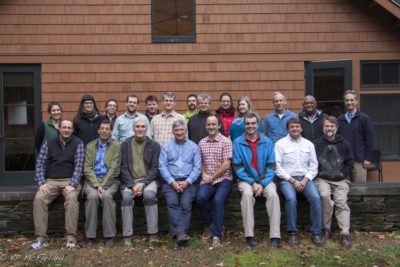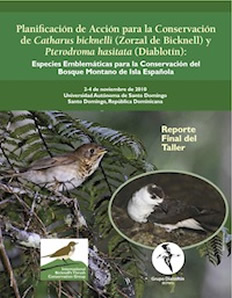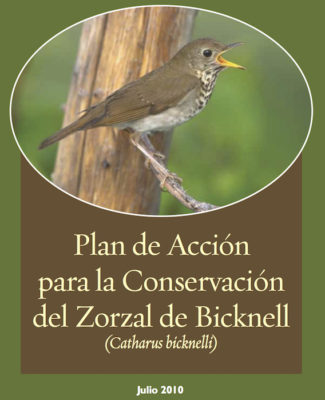A Threatened Species
Each spring, across a small section of northeastern North America, dawn comes with an event witnessed nowhere else on Earth. It happens in a zone of mountainous and coastal forest sites scattered across southeastern Canada and the northeastern United States. As the day begins, these forests come alive with the swirling song of the Bicknell’s Thrush.
Arriving after a 2,000-kilometer migration from wintering grounds in the Greater Antilles, the thrushes will breed and raise young in these forests, not far removed from population centers with millions of people. A scant four months later, they will depart and migrate south before the onset of winter. With each journey, north or south, Bicknell’s Thrush flies toward an uncertain future.
A Coordinated Response
Already one of the continent’s rarest breeding songbirds, Bicknell’s Thrush now faces threats at nearly every stage of its life. In response, a coalition of scientists, natural resource managers and conservation planners, forming the International Bicknell’s Thrush Conservation Group (IBTCG), has been working to study and conserve this enigmatic, captivating songbird. The IBTCG’s efforts have culminated in an innovative plan of action designed to help recover Bicknell’s Thrush populations.
The Revised Conservation Action Plan for Bicknell’s Thrush
 In November 2015, five years after the first Plan was released, the IBTCG met once again in Woodstock, Vermont—site of the inaugural IBTCG meeting in 2007—to begin the process of revising the Plan. The two-day workshop highlighted significant progress towards the goals of the Plan, but also reinforced the need for continued action on behalf of Bicknell’s Thrush and its habitat. Actions taken by the IBTCG since the release of the first Plan have mitigated some important threats to Bicknell’s Thrush, but others remain largely unabated. As such, the IBTCG recognized the need for an updated and revised Plan that would catalyze action and guide the collective efforts of those interested in conservation of Bicknell’s Thrush.
In November 2015, five years after the first Plan was released, the IBTCG met once again in Woodstock, Vermont—site of the inaugural IBTCG meeting in 2007—to begin the process of revising the Plan. The two-day workshop highlighted significant progress towards the goals of the Plan, but also reinforced the need for continued action on behalf of Bicknell’s Thrush and its habitat. Actions taken by the IBTCG since the release of the first Plan have mitigated some important threats to Bicknell’s Thrush, but others remain largely unabated. As such, the IBTCG recognized the need for an updated and revised Plan that would catalyze action and guide the collective efforts of those interested in conservation of Bicknell’s Thrush.
This revised Plan reflects the consensus of the IBTCG about the primary threats facing Bicknell’s Thrush and the actions that may help mitigate those threats. It does not provide a comprehensive list of every threat to Bicknell’s Thrush, but instead attempts to focus on those believed to pose the greatest risk of further endangerment of the species. It does not identify every action that might prove useful in mitigating threats; rather, it singles out actions believed to have a higher probability of success based on published research or the personal experience of contributors to the revised Plan. The revised Plan is a tool for communicating about the conservation of Bicknell’s Thrush, both within the community of scientists and conservation practitioners that make up IBTCG and more broadly to policy makers, elected officials, and the public. Finally, the revised Plan is intended as a guide to investing limited resources for conservation most effectively.
The First Conservation Action Plan
The first Conservation Action Plan was released in 2010 and had a planned lifespan of 5 years. This Plan highlights the priority conservation actions needed to address factors contributing to the global vulnerability of Bicknell’s Thrush. It is not an exhaustive review or assessment of the species’ status. Rather, the Plan summarizes salient life history characteristics of Bicknell’s Thrush, identifies factors that may limit its populations, proposes desired population and habitat goals for conservation, and describes critical activities needed to achieve those targets. Actions taken by the IBTCG since the release of the first Plan have mitigated some important threats to Bicknell’s Thrush, but others remain largely unabated. The IBTCG recognized the need for an updated and revised Plan that would continue to catalyze action and guide the collective efforts of those interested in conservation of Bicknell’s Thrush.
Plan Implementation
The IBTCG held its fourth annual meeting, in conjunction with the Black-capped Petrel Working Group, in Santo Domingo, Dominican Republic on 2-4 November 2010. Sixty conservation biologists from seven countries representing three languages spent three days focused on increasing cooperation between Caribbean and North American IBTCG partners through hands-on engagement in implementing the Conservation Action Plan.
 Workshop Report
Workshop Report
Conservation Action Planning for Bicknell’s Thrush and Black-capped Petrel: Flagships for Montane Forest Conservation on Hispaniola


